Dick's Bundle
Who Really Owns Dick's Sporting Goods?
Ever wondered who steers the ship at one of America's leading sporting goods retailers? The ownership structure of Dick's Sporting Goods dictates its strategic moves, from product offerings to market expansion. Understanding Dick's Sporting Goods SWOT Analysis is crucial to grasping the company's position. This deep dive explores the evolution of Dick's ownership, tracing its roots from a small bait shop to a retail powerhouse.
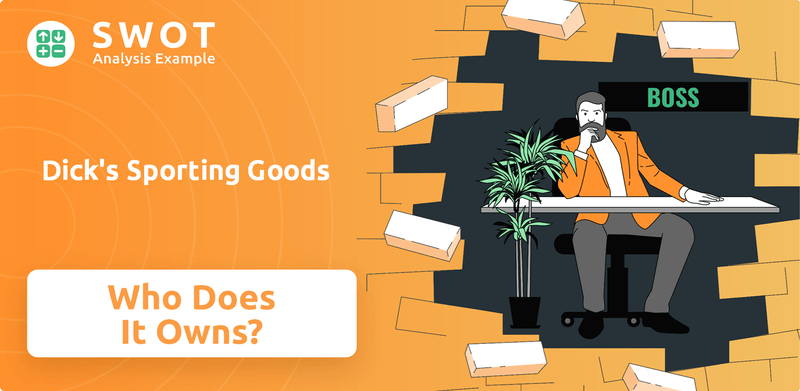
From its humble beginnings in 1948, Dick's Sporting Goods has transformed significantly, reflecting changes in its ownership and corporate structure. The company's history is a fascinating narrative of growth and adaptation, influenced by key figures and market dynamics. This exploration will shed light on the current ownership landscape, including major shareholders and the influence of the Dick's CEO, providing a comprehensive view of this retail giant.
Who Founded Dick's Sporting Goods?
The story of Dick's Sporting Goods begins with Richard 'Dick' Stack, who founded the company in 1948. His initial vision was to provide a comprehensive selection of sporting goods to customers. The early days of the company were marked by Dick Stack's singular control and ownership.
Dick Stack's initial investment of $300 from his grandmother was the seed that started the business. This early investment highlights the humble beginnings of what would become a major player in the sporting goods retail industry. The company's early structure was straightforward, reflecting its family-run nature.
As the sole proprietor, Dick Stack held primary ownership and control during the formative years. The company's early success was built on Dick Stack's vision and hands-on management style. The focus was on building a solid foundation for the business.
Founded in 1948 by Richard 'Dick' Stack.
Started with a $300 investment from Dick Stack's grandmother.
Dick Stack was the primary owner and held complete control.
Focused on providing a wide selection of sporting goods.
The company was initially structured as a small, family-run business.
Early agreements were informal due to the company's nascent stage.
The early ownership of Dick's Sporting Goods, with Dick Stack at the helm, set the stage for the company's future growth. The Marketing Strategy of Dick's Sporting Goods has evolved significantly since its inception, but the foundational principles of providing a wide selection of sporting goods and a customer-focused approach remain central to the company's identity. The company's early success was directly tied to Dick Stack's vision and hands-on management, which shaped its corporate structure and laid the groundwork for its expansion. As of early 2024, the company continues to evolve, but its origins remain firmly rooted in the vision of its founder.
Dick's SWOT Analysis
- Complete SWOT Breakdown
- Fully Customizable
- Editable in Excel & Word
- Professional Formatting
- Investor-Ready Format
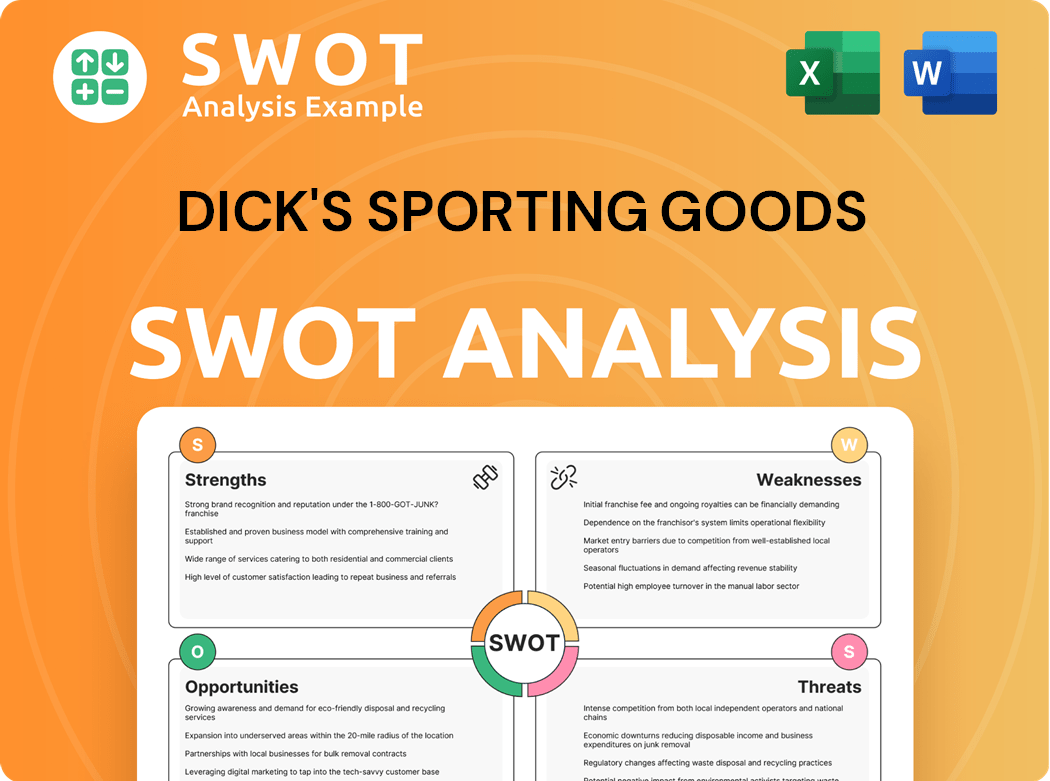
How Has Dick's Sporting Goods’s Ownership Changed Over Time?
The evolution of Dick's Sporting Goods' ownership marks a significant shift from a family-run enterprise to a publicly traded corporation. The pivotal moment occurred on October 15, 2002, when the company launched its Initial Public Offering (IPO) and began trading on the New York Stock Exchange under the ticker symbol DKS. This transition broadened the ownership base, moving it from the Stack family to a diverse group of public shareholders, including institutional and individual investors. This strategic move provided the capital needed for expansion and growth, fundamentally altering the company's structure and governance.
As of early 2025, the ownership structure of Dick's Sporting Goods is largely dominated by institutional investors, mutual funds, and index funds. These entities collectively hold a substantial portion of the company's outstanding shares. Major players like Vanguard Group Inc. and BlackRock Inc. consistently appear among the top institutional holders. Their significant stakes give them considerable influence over corporate strategy through their voting rights on key decisions. The original ownership, though diluted by subsequent stock offerings and market transactions, still maintains a family presence. Edward Stack, son of the founder, continues to hold a significant role as Executive Chairman, ensuring continuity in governance.
| Event | Date | Impact on Ownership |
|---|---|---|
| Company founded | 1948 | Private, family-owned |
| IPO | October 15, 2002 | Publicly traded; increased shareholder base |
| Ongoing | 2002-Present | Institutional investors become major stakeholders; family influence continues |
The shift to public ownership has increased the need for transparency and accountability. Dick's Sporting Goods regularly files reports with the SEC, detailing its financial performance and ownership structure. The company's journey from a small, family-owned business to a publicly traded entity reflects its growth and adaptation in the competitive retail market. For a deeper dive into the company's financial operations, check out the Revenue Streams & Business Model of Dick's Sporting Goods.
Dick's Sporting Goods transitioned from family ownership to a public company via an IPO in 2002.
- Institutional investors hold a significant portion of shares.
- Vanguard and BlackRock are among the top institutional holders.
- Edward Stack, son of the founder, remains Executive Chairman.
- Public filings ensure transparency and accountability.
Dick's PESTLE Analysis
- Covers All 6 PESTLE Categories
- No Research Needed – Save Hours of Work
- Built by Experts, Trusted by Consultants
- Instant Download, Ready to Use
- 100% Editable, Fully Customizable
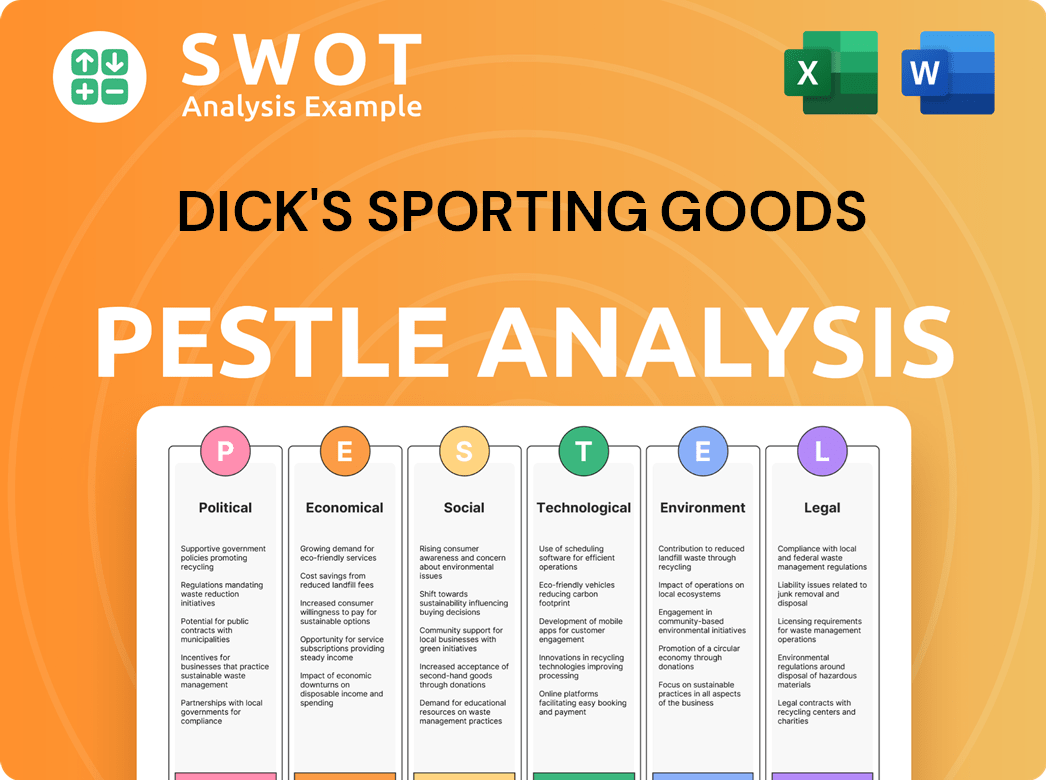
Who Sits on Dick's Sporting Goods’s Board?
As of early 2025, the Board of Directors of Dick's Sporting Goods includes a mix of individuals. Edward W. Stack, the son of the founder, holds the Executive Chairman position, maintaining family leadership. Lauren Hobart serves as President and Chief Executive Officer and is also on the Board. The board generally comprises members with experience in retail, finance, and technology, often including independent directors.
The board's composition reflects a commitment to both continuity and fresh perspectives. This blend helps guide the company's strategic direction and oversee its operations. The board's decisions are subject to scrutiny from major institutional investors who collectively hold significant voting power, ensuring a degree of accountability and alignment with shareholder interests.
| Board Member | Title | Key Role |
|---|---|---|
| Edward W. Stack | Executive Chairman | Oversees board activities and strategic direction |
| Lauren Hobart | President and CEO | Leads company operations and strategy |
| Independent Directors | Various | Provide diverse expertise and oversight |
The voting structure at Dick's Sporting Goods follows a one-share-one-vote basis. This means each share of common stock typically grants one vote on shareholder matters. There's no public information suggesting dual-class shares or special voting rights. This structure ensures that voting power is proportional to share ownership, promoting a transparent and equitable governance system.
Understanding the board of directors and voting structure is key to understanding Dick's Sporting Goods. The board includes family members and independent directors. The voting structure is straightforward, with one vote per share.
- Edward W. Stack is the Executive Chairman.
- Lauren Hobart is the President and CEO.
- Voting is one share, one vote.
- Institutional investors hold significant voting power.
Dick's Business Model Canvas
- Complete 9-Block Business Model Canvas
- Effortlessly Communicate Your Business Strategy
- Investor-Ready BMC Format
- 100% Editable and Customizable
- Clear and Structured Layout
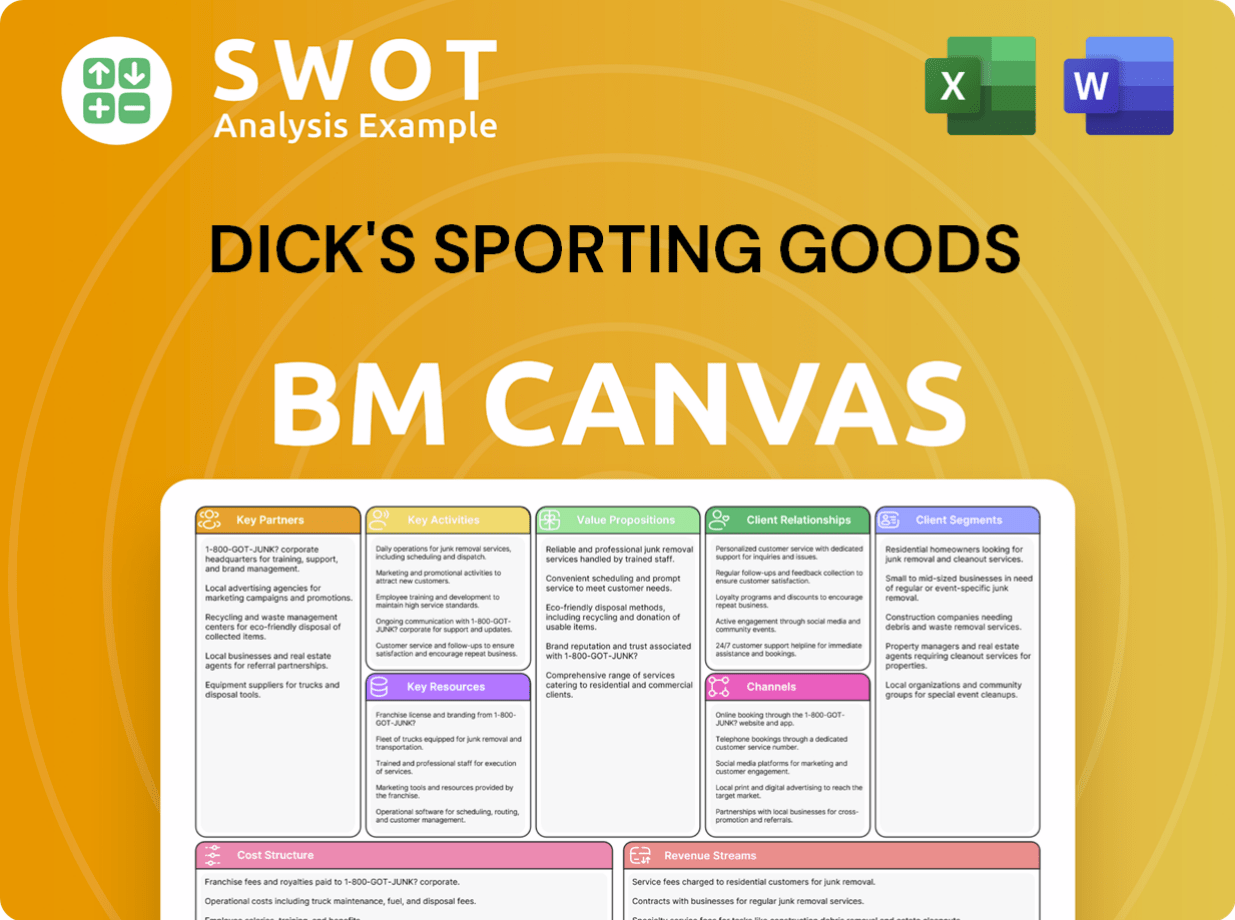
What Recent Changes Have Shaped Dick's Sporting Goods’s Ownership Landscape?
In the past few years, several developments have influenced the ownership structure of Dick's Sporting Goods. The company has actively engaged in share buyback programs, a strategy that reduces the number of outstanding shares. This action can potentially increase the value of the remaining shares, thereby concentrating ownership among existing shareholders. For instance, in fiscal year 2023, Dick's repurchased around 2.9 million shares of its common stock for $380.0 million, demonstrating a strategic use of capital to boost shareholder value. This approach reflects a commitment to enhancing shareholder returns through direct financial actions.
While there haven't been major leadership or founder departures significantly altering the ownership structure recently, the Stack family's influence continues through Edward Stack's role as Executive Chairman. Industry trends, such as increased institutional ownership, are also apparent within Dick's Sporting Goods. Large asset managers like Vanguard and BlackRock consistently hold substantial stakes. This trend can lead to a greater focus on environmental, social, and governance (ESG) factors, as these institutions often prioritize sustainable and responsible corporate practices. The company has not announced any immediate plans for privatization or major changes in its listing status, which suggests a continued commitment to its public ownership model. To understand more about the company's strategic growth, you can read about the Growth Strategy of Dick's Sporting Goods.
| Ownership Category | Stakeholders | Approximate Ownership |
|---|---|---|
| Institutional Investors | Vanguard Group, BlackRock, etc. | Significant, collectively over 70% |
| Individual Shareholders | Public investors | Variable, depends on market activity |
| Insiders (Executive Leadership) | Edward Stack (Executive Chairman) | Significant, but variable |
Dick's Sporting Goods remains a publicly traded company, with a significant portion of its shares held by institutional investors. The company's commitment to share buybacks and the sustained influence of key leadership figures highlight the ongoing dynamics in its ownership structure. These factors are key to understanding who owns Dick's and the broader corporate structure of the company.
Share buybacks have reduced outstanding shares.
Vanguard and BlackRock hold substantial shares.
Edward Stack continues to influence the company.
Dick's remains a public company.
Dick's Porter's Five Forces Analysis
- Covers All 5 Competitive Forces in Detail
- Structured for Consultants, Students, and Founders
- 100% Editable in Microsoft Word & Excel
- Instant Digital Download – Use Immediately
- Compatible with Mac & PC – Fully Unlocked
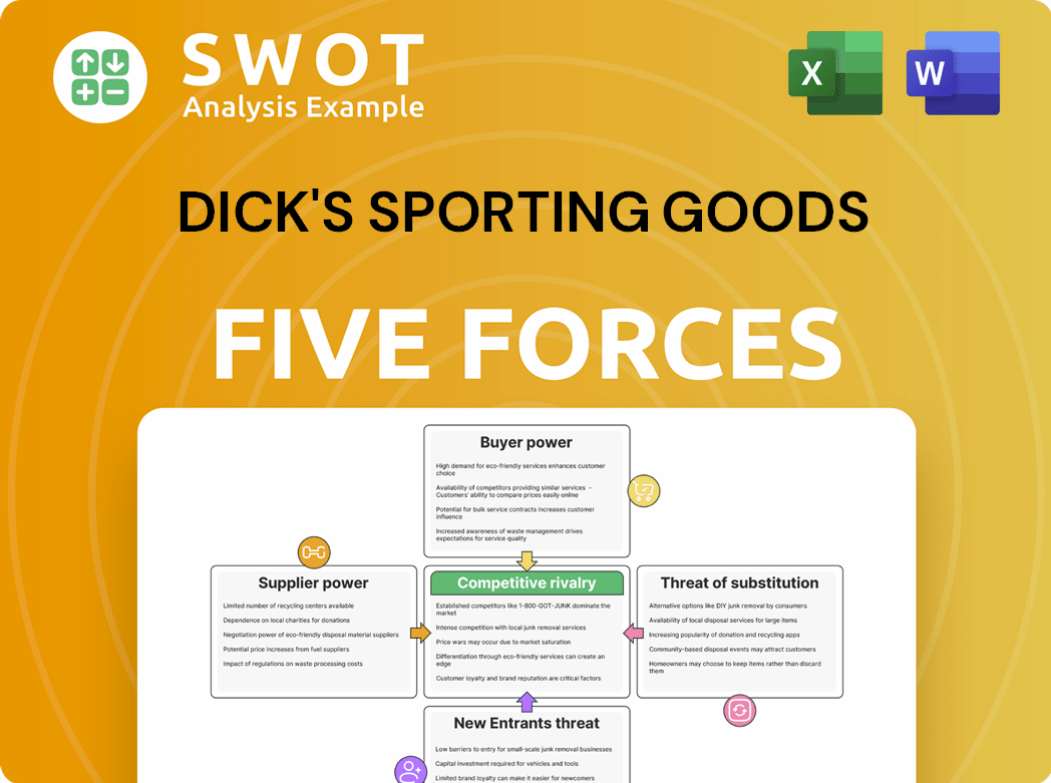
Related Blogs
- What are Mission Vision & Core Values of Dick's Sporting Goods Company?
- What is Competitive Landscape of Dick's Sporting Goods Company?
- What is Growth Strategy and Future Prospects of Dick's Sporting Goods Company?
- How Does Dick's Sporting Goods Company Work?
- What is Sales and Marketing Strategy of Dick's Sporting Goods Company?
- What is Brief History of Dick's Sporting Goods Company?
- What is Customer Demographics and Target Market of Dick's Sporting Goods Company?
Disclaimer
All information, articles, and product details provided on this website are for general informational and educational purposes only. We do not claim any ownership over, nor do we intend to infringe upon, any trademarks, copyrights, logos, brand names, or other intellectual property mentioned or depicted on this site. Such intellectual property remains the property of its respective owners, and any references here are made solely for identification or informational purposes, without implying any affiliation, endorsement, or partnership.
We make no representations or warranties, express or implied, regarding the accuracy, completeness, or suitability of any content or products presented. Nothing on this website should be construed as legal, tax, investment, financial, medical, or other professional advice. In addition, no part of this site—including articles or product references—constitutes a solicitation, recommendation, endorsement, advertisement, or offer to buy or sell any securities, franchises, or other financial instruments, particularly in jurisdictions where such activity would be unlawful.
All content is of a general nature and may not address the specific circumstances of any individual or entity. It is not a substitute for professional advice or services. Any actions you take based on the information provided here are strictly at your own risk. You accept full responsibility for any decisions or outcomes arising from your use of this website and agree to release us from any liability in connection with your use of, or reliance upon, the content or products found herein.